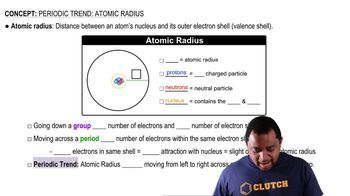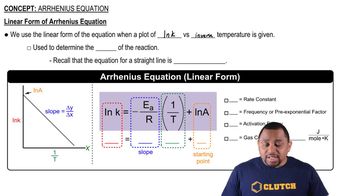Millikan determined the charge on the electron by studying the static charges on oil drops falling in an electric field (Figure 2.5). A student carried out this experiment using several oil drops for her measurements and calculated the charges on the drops. She obtained the following data: Droplet Calculated Charge (C) A 1.60 * 10-19 B 3.15 * 10-19 C 4.81 * 10-19 D 6.31 * 10-19 (c) What value (and to how many significant figures) should she report for the electronic charge?
Ch.2 - Atoms, Molecules, and Ions

Brown14th EditionChemistry: The Central ScienceISBN: 9780134414232Not the one you use?Change textbook
Chapter 2, Problem 20b
The radius of an atom of copper (Cu) is about 140 pm. (b) How many Cu atoms would have to be placed side by side to span a distance of 5.0 mm?
 Verified step by step guidance
Verified step by step guidance1
First, convert the radius of a copper atom from picometers (pm) to millimeters (mm). Since 1 pm = 1 x 10^-12 meters and 1 mm = 1 x 10^-3 meters, you can convert the radius to millimeters.
Next, calculate the diameter of a copper atom. Since the radius is half of the diameter, multiply the radius by 2 to find the diameter in millimeters.
Determine how many copper atoms are needed to span 5.0 mm by dividing the total distance (5.0 mm) by the diameter of one copper atom in millimeters.
Set up the division to find the number of copper atoms: Total distance (5.0 mm) divided by the diameter of one copper atom (in mm).
Finally, perform the division to find the number of copper atoms that fit side by side in the given distance.

Verified video answer for a similar problem:
This video solution was recommended by our tutors as helpful for the problem above.
Video duration:
1mWas this helpful?
Key Concepts
Here are the essential concepts you must grasp in order to answer the question correctly.
Atomic Radius
The atomic radius is a measure of the size of an atom, typically defined as the distance from the nucleus to the outermost electron shell. For copper (Cu), the atomic radius is approximately 140 picometers (pm), which is essential for calculating how many atoms can fit in a given distance.
Recommended video:
Guided course

Atomic Radius
Unit Conversion
Unit conversion is the process of converting a quantity expressed in one unit to another unit. In this question, it is necessary to convert millimeters (mm) to picometers (pm) to ensure that the measurements are compatible when calculating how many copper atoms fit into a specified distance.
Recommended video:
Guided course

Conversion Factors
Linear Arrangement
Linear arrangement refers to the placement of objects in a straight line. In this context, it involves determining how many copper atoms, each with a radius of 140 pm, can be placed side by side to cover a total distance of 5.0 mm, which requires dividing the total distance by the diameter of a single copper atom.
Recommended video:
Guided course

Linear Form of Arrhenius Equation
Related Practice
Textbook Question
36
views
Textbook Question
The radius of an atom of tungsten (W) is about 2.10 Å. (c) If the atom is assumed to be a sphere, what is the volume in m3 of a single W atom?
8
views
Textbook Question
The radius of an atom of copper (Cu) is about 140 pm. (a) Express this distance in angstroms 1A 2.
7
views
Textbook Question
The radius of an atom of copper (Cu) is about 140 pm. (c) If you assume that the Cu atom is a sphere, what is the volume in cm3 of a single atom?
2
views
Textbook Question
Determine whether each of the following statements is true or false. If false, correct the statement to make it true: (a) The nucleus has most of the mass and comprises most of the volume of an atom.
7
views
1
rank
